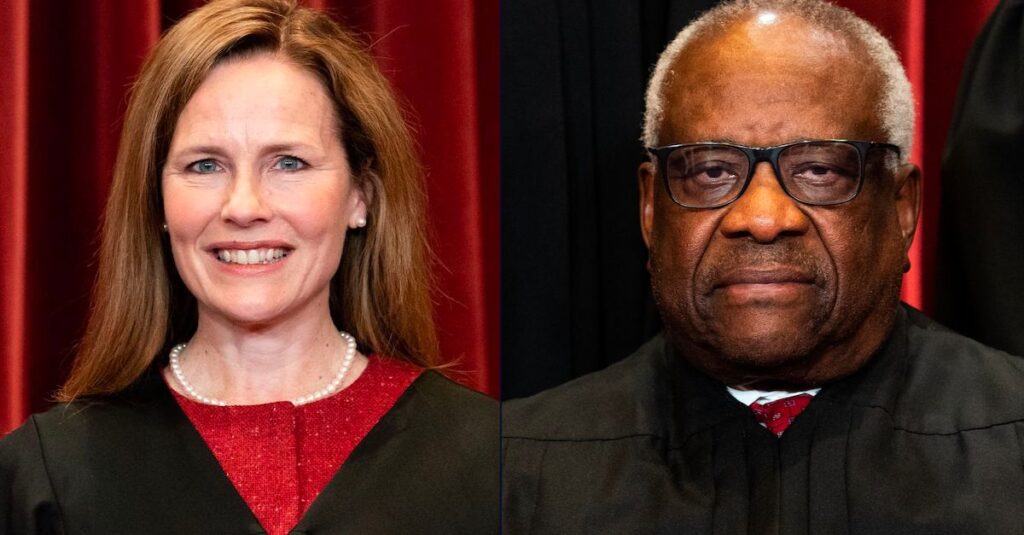In a landmark decision on June 13, 2024, the United States Supreme Court delivered a unanimous ruling in Vidal v. Elster, a case that has garnered significant public and legal interest. Central to this decision was a striking exchange between two of the Court’s conservative justices: Amy Coney Barrett and Clarence Thomas. This article explores the case’s background, the arguments presented, and the notable judicial clash that has highlighted differing interpretations within the Supreme Court’s conservative wing.
Background of Vidal v. Elster
The case of Vidal v. Elster began in 2018 when Steve Elster sought to register the phrase “TRUMP TOO SMALL” for use on T-shirts and other merchandise. The U.S. Patent and Trademark Office (PTO) rejected this application, citing the Lanham Act, which prohibits the registration of trademarks that contain the names of living persons without their consent. Elster challenged this decision, arguing that the denial violated his First Amendment rights.
After the U.S. Court of Appeals for the Federal Circuit found the PTO’s decision unconstitutional, the case made its way to the Supreme Court. The central issue was whether the Lanham Act’s restrictions on registering trademarks referencing living individuals without their consent infringes on free speech.
The Majority Opinion: Justice Thomas
Justice Clarence Thomas, known for his originalist judicial philosophy, authored the majority opinion, joined by Justices Samuel Alito and Neil Gorsuch. Thomas’s opinion firmly rejected Elster’s First Amendment claims, arguing that the Lanham Act’s provisions do not violate free speech because trademark law has historically involved content-based distinctions, not viewpoint-based ones.
Thomas traced the history of trademark regulation, noting that it has always included mechanisms to protect the names and identities of living persons from commercial exploitation without their consent. He emphasized that this tradition aligns with the constitutional framework and does not inherently suppress free speech.
“Elster contends that this prohibition violates his First Amendment right to free speech. We hold that it does not,” wrote Justice Thomas. He further explained that the use of a name, whether flattering, critical, or neutral, falls under the content-based distinctions historically inherent in trademark law.
Justice Barrett’s Concurring Opinion
While the ruling was unanimous, Justice Amy Coney Barrett took a different interpretative approach in her concurring opinion. Barrett challenged Thomas’s reliance on historical precedent, arguing that the Court’s application of the “history and tradition” test has not always been consistent and that such a framework can sometimes obscure more nuanced constitutional issues.
Barrett’s opinion highlighted the complexities of applying historical analogues to modern cases, particularly in areas like trademark law that have evolved significantly over time. She pointed out that Thomas’s argument oversimplified the relationship between trademark protections and free speech and advocated for a more critical examination of how these protections interact with contemporary First Amendment principles.
In a notable footnote, Barrett clarified her position: “Justice Thomas mistakenly suggests that I present the federal trademark register as a limited public forum. That is not my position. Rather, I view the content-based nature of the limited public forum as analogous to the trademark registration system. Moreover, by characterizing my argument as a conclusory statement that the limited public forum framework is ‘apt,’ Justice Thomas ignores my reasons for drawing the analogy.”
Implications of the Ruling
The Supreme Court’s decision in Vidal v. Elster has significant implications for trademark law and free speech jurisprudence. By upholding the Lanham Act’s provisions, the Court reaffirmed the balance between protecting individuals’ rights to their names and identities and the broader principles of free expression.
For legal scholars and practitioners, the ruling underscores the importance of understanding the historical context of laws while also considering their application in modern contexts. Barrett’s concurring opinion, in particular, suggests a more dynamic approach to constitutional interpretation that could influence future cases involving conflicts between historical precedent and contemporary rights.
The Broader Judicial Context
The exchange between Barrett and Thomas is illustrative of a broader ideological debate within the Supreme Court. Both justices are part of the Court’s conservative majority, yet their differing views reflect the diversity of thought within this bloc. Thomas’s originalist approach, which prioritizes historical interpretations of the Constitution, often contrasts with Barrett’s more pragmatic stance that considers the evolving nature of legal and societal contexts.
This case also highlights the role of concurring opinions in shaping legal discourse. While concurring opinions do not carry the weight of the majority ruling, they provide valuable insights and arguments that can influence future judicial reasoning and legal scholarship. Barrett’s opinion may serve as a reference point for future cases that address the intersection of free speech and trademark law.
